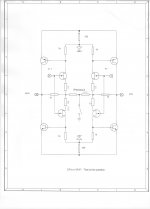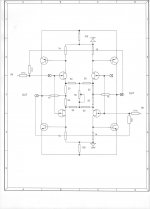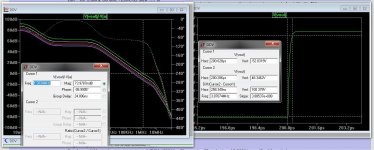Externally, yes. And for app engineers, yes.
So, if you wouldn't see the internal simplified schematic (aka peeking) how would you know it's a CFA?
What is this http://www.ti.com/lit/ds/symlink/opa659.pdf a CFA or a VFA?
So, if you wouldn't see the internal simplified schematic (aka peeking) how would you know it's a CFA?
Maybe you would not know nor need to know.... unless you are designing the internal circuitry. Or doing it discretely.... as we do here.
If the CFA circuit internally has the fb going to the low Z (-) port but the input goes to same port via thru an added buffer, what is it?
THx-RNMarsh
Opened.
Shouldn't this post be on the food thread? Or are you fishing? Nice image. 🙂
I can't decide if a Warhol museum is the last thing he would have wanted or not...
Probably would love it. But if you are really curious I can ask Sidney.
The Early Life of Andy Warhol | Crystal Bridges Museum of American Art
BTY Until you actually see any of his works even a signature you won't believe just how good a draftsman he was. Even his early graffiti signatures are amazing. When you just see the reproductions the impact of his art is quite diminished.
Last edited:
Externally, yes. And for app engineers, yes. It wont matter much to them. But internally, the window of operational parameters, are still CFA. Unless, of course we redefine for simplicity sake that only the Z of the inputs ports defines a CFA or VFA..... which many are also trying to do.
THx-RNMarsh
It has the UGLF and bode "slope" of a CFA (below) .... link where I went through all this and Thimios actually built it - http://www.diyaudio.com/forums/solid-state/248105-slewmaster-cfa-vs-vfa-rumble-105.html#post4120777
With the high Z NFB ... yes, it is a VFA. But internally it slews and has
the gain margins of a CFA.
Much more CFA "like" than VFA.
(below 2) we actually simulated and built it. It is a "EFA" (excellent flippin' amp). 😀
OS
Attachments
Last edited:
So, if you wouldn't see the internal simplified schematic (aka peeking) how would you know it's a CFA?
What is this http://www.ti.com/lit/ds/symlink/opa659.pdf a CFA or a VFA?
Fig. 26 (LG/phase) ....looks like a VFA.
OS
It has the UGLF and bode "slope" of a CFA (below) .... link where I went through all this and Thimios actually built it - http://www.diyaudio.com/forums/solid-state/248105-slewmaster-cfa-vs-vfa-rumble-105.html#post4120777
With the high Z NFB ... yes, it is a VFA. But internally it slews and has
the gain margins of a CFA.
Much more CFA "like" than VFA.
(below 2) we actually simulated and built it. It is a "EFA" (excellent flippin' amp). 😀
OS
Though this is not what i described, it has all been a lot of fun.... you, Dadod and Bonsai did a lot of work to understand the differences and then find ways to close the gaps between VFA and CFA. I think WE have moved the needle in Audio by exploring all this. Incredible designs have come from it. And, I'll put my money where my mouth is to buy and use them and promote their further use in pro and home designs.
And, there is Johns design he just showed. He has been at it for a longer time.
THx-RNMarsh
Last edited:
This is deja vu all over again. Why is this coming up again now?
Sorry if my post started that again, I just wanted to show a power amp with fully balanced input.
I tried to get that and keep pure CFA configuration adding only one buffer, but there was to much distortion. Now there are two buffers, one to have high impedance feedback input and second one to get fully balanced input impedances and high CMRR.
No problem.Sorry if my post started that again, I just wanted to show a power amp with fully balanced input.
I tried to get that and keep pure CFA configuration adding only one buffer, but there was to much distortion. Now there are two buffers, one to have high impedance feedback input and second one to get fully balanced input impedances and high CMRR.
I worry that exchanges in here are going to get to the point where we are just posting links to other portions of the thread, like the gag where everyone has heard the jokes and assigned them numbers, and someone says "42!" and everybody laughs.
What about this schematic?
I used a similar conceptual design about ten years ago for Dave Wilson's built-in subwoofer amplifier..... 900W/4 at very low thd. Fully balanced from input to output.
In fact, I got the idea from you.... you sketched it on a napkin in Berkeley many many years ago when we were trading info on low distortion ideas.... and I told you about the cancelling C of devices tests I did and nulling thd. Back when I lived in the Bay area. I left the bay Area about 20 years ago... so it was years before then.
Funny how things come back when you need them to but are otherwise completely forgotten about.
42
THx-RNMarsh
Last edited:
"42!" and everybody laughs.
No one laughs at 42... That's a very serious number..... 🙂
I wouldn't add the extra complexity unless there was some compelling need for a balanced input Z for a signal source.
I have never found such inputs needed for best sound/performance in a home audio environment. But sometimes there is a compelling audiophile Marketing need.
THx-RNMarsh
This is curious. You fret about hi-rez recordings yet are completely happy to have zero common mode rejection in your system. Surely signal integrity should be high on the list with the highest resolution recording and converters?
Good idea, because it does not. That's according to your own criteria, and also according with e.g. the LM6171 data sheet.
Nice try Waly.
That's not necessarily a CFA since we do not know what is inside the gain block marked A, and critically, how its compensated. Dados design is a true 'H' bridge CFA in my view.
I'm with Ostripper and Richard on this one.
Sorry Scott - you are one smart guy and I have enormous respect for ADI - but I'm sticking to my version of what constitutes a CFA. No hard feelings I hope 🙂
With respect to power amplifiers as discussed here, what's important to recognize in this discussion (and I think I only came to realize this sometime after making my case about 2 years ago) is in terms of behaviour, its really a continuum between the two. As you raise loop gains in CFA, their behaviour morphs into VFA and you have all the familiar comp issues to deal with.
If you are struggling to understand this CFA/VFA thing, just use the two tests and two pointers method.
Now I definitely do not want to discuss this further because, like politics, the views are entrenched and no one is going to budge.
Last edited:
If you are struggling to understand this CFA/VFA thing, just use the two tests and two pointers method.
Who, me? Now that's really, really funny.
Ok, I give up.
- Status
- Not open for further replies.
- Home
- Member Areas
- The Lounge
- John Curl's Blowtorch preamplifier part II




